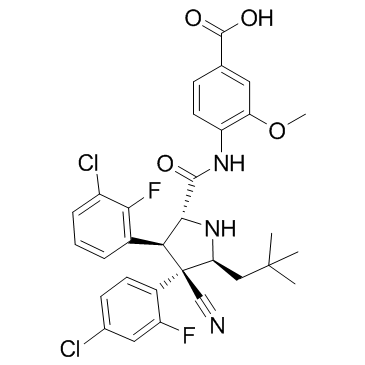| Description |
Idasanutlin (RG7388) is a potent and selective MDM2 antagonist, inhibiting p53-MDM2 binding, with an IC50 of 6 nM.
|
| Related Catalog |
|
| Target |
IC50: 6 nM (p53-MDM2)[1]
|
| In Vitro |
Idasanutlin (RG7388) inhibits cell proliferation with IC50 of 30 nM, and induces dose-dependent p53 stabilization, cell cycle arrest, as well as cell apoptosis in cancer cells expressing wild-type p53[1]. Idasanutlin (RG7388) (300 nM or 1.8 μM) induces apoptosis in SJSA osteosarcoma cells[2].
|
| In Vivo |
Idasanutlin (RG7388, 25 mg/kg p.o.) results in tumor growth inhibition and regression, in the mouse SJSA human osteosarcoma xenograft model[1]. Idasanutlin (RG7388) induces induction of apoptosis and antiproliferation, in the SJSA xenograft model[2].
|
| Cell Assay |
Cell proliferation is evaluated by the tetrazolium dye assay. The concentration at which 50% inhibition (IC50) or 90% inhibition (IC90) of cell proliferation is determined from the linear regression of a plot of the logarithm of the concentration versus percent inhibition.
|
| Animal Admin |
At 10 to 12 weeks of age, mice are implanted with a 1:1 mixture of human SJSA osteosarcoma cells (ATCC) suspended in phenol-free Matrigel and PBS. Mice are implanted in the right flank at a concentration of 5×106 cells in 0.2 mL total volume. At approximately day 10, animals are randomized according to tumor volume, so that all groups of 10 randomized mice have similar starting mean tumor volumes of 100 to 250 mm3. Idasanutlin (RG7388) is administered as an amorphous solid dispersion microbulk precipitate powder containing 30% drug substance and 70% hydroxypropyl methylcellulose acetate succinate polymer that is reconstituted immediately before administration as a suspension in Klucel/Tween, and remaining suspension is discarded after dosing.
|
| References |
[1]. Ding Q, et al. Discovery of RG7388, a potent and selective p53-MDM2 inhibitor in clinical development. J Med Chem. 2013 Jul 25;56(14):5979-83. [2]. Higgins B, et al. Preclinical optimization of MDM2 antagonist scheduling for cancer treatment by using a model-based approach. Clin Cancer Res. 2014, 20(14), 3742-3752.
|
